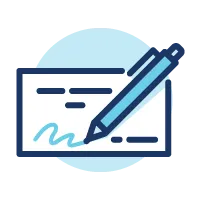Are you a student who’s thinking about getting your very first credit card? Getting a credit card and using it wisely is a huge step towards financial independence. Don’t miss these tips for making sure you ace the test on responsible credit card use.
5 Best Practices for Students Using Credit Cards
When it comes to applying for and then using a credit card as a student, there are few things you'll need to understand to become successful.
1. Primary Goal is to Build Your Credit
The primary goal for all students using a credit card is to build credit.
To understand how to do that, you should know that your credit score is based on five separate factors that can be reflected either positively or negatively in how you use your student credit card.
The five factors that make up your credit are:
How is Your Credit Score Calculated?
Payment History (35%)
Your history of borrowing money and paying it back on time is the best way for lenders to decide how much they trust you.
Amounts Owed (30%)
Lenders want to see how much debt someone has compared to the amount they have available to borrow.
Length of Credit History (15%)
A longer credit history gives lenders a better idea of a borrower's behavior with borrowing money.
Credit Mix (10%)
If a lender can see the borrower is able to manage a mortgage, a student loan, and a credit card, then this makes the borrower less of a risk to the potential lender.
New Credit (10%)
New credit can both increase and decrease the overall score.
As you can see, the majority of your credit score is factored in how much you owe on your credit card and if you pay off your credit card balance on time or not.
2. Understand the Risks of Credit Cards
Getting your first credit card can be an incredibly positive and rewarding experience. However, there are some serious risks you need to be aware of.
- Credit card debt – It can be easy to borrow more than you can pay back each month. Avoid debt by sticking to a budget and only using your credit card for expenses you can pay each month.
- Missed payments – Missing payments can have long lasting impacts on your credit. You’ll also likely be charged late fees. Avoid missed payments by taking advantage of automatic payments through online banking.
- High interest – Credit cards can come with high interest rates. Avoid paying interest by only charging what you can pay off each month.
3. Keep Your Credit Utilization Low
Credit utilization is a fancy term that simply means how much you owe compared to your credit limit.
For example, if you have a credit limit of $1,000 and a balance of $250, then your credit utilization is 25%.
$250 (Credit Balance)
$1,000 (Credit Limit)
=
25% (Credit Utilization)
Your goal should be to keep your credit utilization at 30% or below. This will help you build and improve your credit.
However, the opposite is also true. If you carry a high balance, or even worse you max out your student credit card, this will negatively impact your credit score .
4. Pay Off Your Credit Card Balance Each Month
The key to becoming and remaining responsible with your credit card as a student is to treat it just like a debit card.
Therefore, when using a credit card, make sure you pay your balance in full each month. One trick is to pay off your credit card balance frequently throughout the month instead of at the end of the month.
If you don't use the card too often, then simply pay the balance on the card right after you use it. If that becomes too much work, then set a reminder to pay off your balance each week.
5. Consider Becoming an Authorized User
If you are having trouble qualifying for a credit card on your own, you may need to become an authorized user on someone else's credit card account.
Often this is done with family members or close friends who know and trust you. By becoming an authorized user, you can build your credit history. Beware that any poor credit card behavior like a missed payment will negatively affect the primary card holder.
One unique practice many students take advantage of is becoming an authorized user but then never actually using or even getting a copy of the credit card. This allows the student to still build their credit history while also minimizing the risk for the primary account holder.
4 Bad Habits to Avoid When Using a Credit Card
Keep in mind that there is always risk involved when using credit cards, especially for new credit card users such as students.
1. Do Not Overspend
When deciding to use a credit card as a student, never allow yourself to spend more than you actually have available to pay off the balance when it's due. Know what your limit is by creating a monthly budget and sticking to it. If you decide to ignore this rule, you may find yourself playing catch up each month — or even worse, falling behind on even the minimum balance due.
That could result in high-interest credit card debt that gets more difficult to get rid of as the balance grows. It’s easy to fall into this type of credit debt card. In fact, did you know the average credit card balance in the United States at the end of 2021 was $5,221 at an average rate of just over 19% APR?
2. Never Consider a Cash Advance
A cash advance looks and feels just like taking cash out of the ATM, however the result is much different — and way more expensive.
Unlike simply using your debit card to withdraw money out of your checking account, a cash advance is technically allowing you to "buy" cash from the ATM rather than using it for goods or services.
Here are some of the fees you can expect to pay:
- Cash advance fees - Some credit cards charge a flat fee around $5 - $10 to use the cash advance feature while other credit card issuers will charge a percentage ranging from around 3% - 5%. It also isn't uncommon for the credit card issuer to use both flat fee and percentage and have you pay whichever is the greater amount.
- ATM or Bank Fees - These are the same fees charged to you when using your ATM card at a different financial institution.
- Interest - Unfortunately, the interest charged on cash advance is much higher than your interest rate for your credit card usage. Also, unlike the grace period on the interest accrued when swiping your credit card, the interest on a cash advance begins accruing immediately.
3. Do Not Open Too Many Cards
Many students are often encouraged to open many cards all at once.
Do not do this.
This will have a negative impact on your credit because each card issuer has to do a hard pull on your credit, thus causing an initial dip in your credit score.
Starting off with multiple credit cards is not a good way to learn how to use them wisely. You are much more likely to miss a payment, overspend, and get yourself into trouble with more than one student credit card.
Instead, start off with just one student credit card and get comfortable with it. If you made it through college without any debt on your student credit card, only then should you consider a second credit card.
4. Avoid Unnecessary Fees
Only choose a card that does not have an annual fee. Many credit cards with highly desirable rewards programs also come with an annual fee. The problem is, as a college student you probably won’t spend enough on the credit card to recoup those rewards to even break even on the annual fee.
Also, keep in mind there are other unnecessary fees to watch out for that include:
- Finance charges fees when you don't pay the balance in full.
- Late fees when you don't pay the minimum amount required by the due date.
- Balance transfer fees when transferring your balance from a high interest rate card to a lower interest rate card.
- Cash advance fees when using your credit card to pull out cash at the ATM.
- Foreign transaction fees when used out of the country.
Final Thoughts on Credit Cards for Students
Just like anything else in life, with risk also comes reward.
With that said, it's important to always understand the risk when it comes to credit cards before you apply for one.
When students use credit cards responsibly you can build credit, which also gives you access to better rates and terms on things you finance after graduation such as a car or a home mortgage loan.
Start off simple, have only one card, pay off the balance each month, and don't chase credit card rewards. Your future self will one day thank you for it.
APR = Annual Percentage Rate











